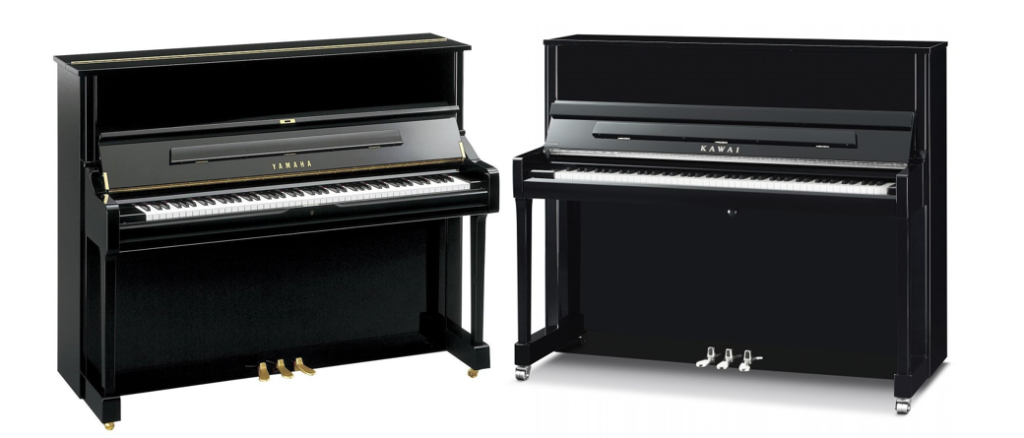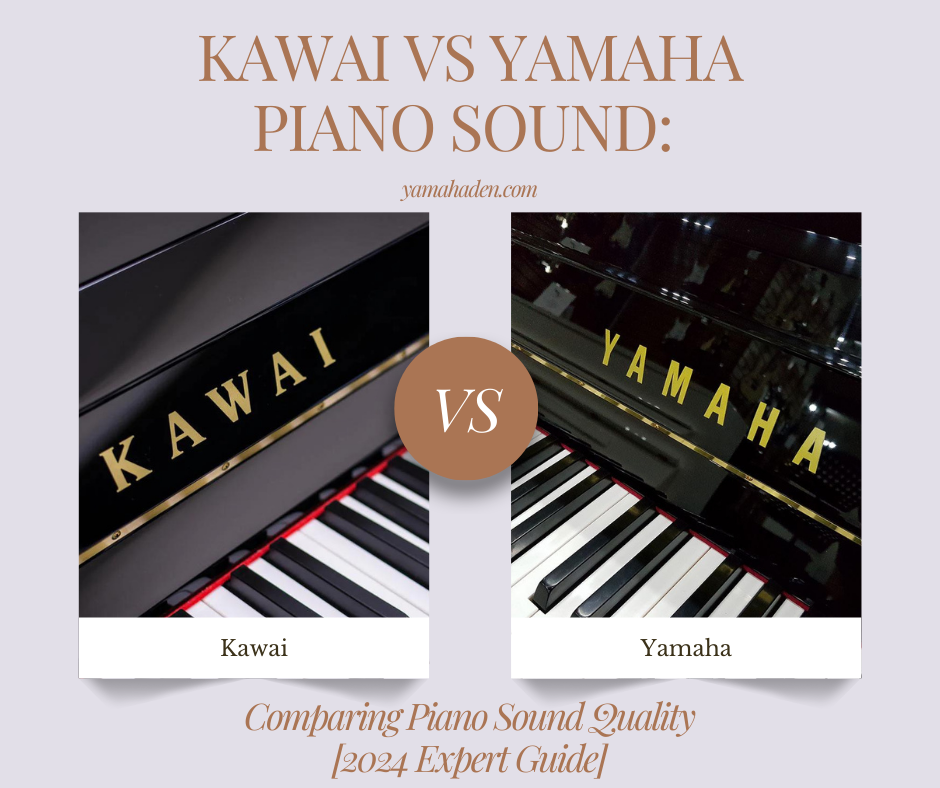Are you in the market for a new piano and debating between Kawai and Yamaha? As an avid pianist, I understand how overwhelming it can be to choose the right instrument. After all, the sound quality is one of the most important factors when selecting a piano. But fear not, because I’m here to help!
In this article, we’ll dive into a detailed comparison of Kawai and Yamaha pianos focusing on their sound quality. We’ll explore each brand’s unique approach to crafting their instruments, their reputation in the music industry, and what experts have to say about their sound. By the end of this article, you’ll have all the information you need to confidently make your decision between these two top-rated piano brands.
So, kawai vs yamaha piano sound?
When it comes to choosing a piano, the sound quality is one of the most important factors to consider. And in this regard, both Kawai and Yamaha are top contenders. While each brand has its own unique characteristics and strengths, there are some key differences that can help you decide which one is right for you.
Kawai pianos are known for their warm and mellow tone, making them popular among classical musicians. They also have a responsive touch and excellent sustain, giving players more control over their dynamics. On the other hand, Yamaha pianos tend to have a brighter and more modern sound with a sharper attack. This makes them favored by jazz and pop musicians who want a crisp sound.
In terms of construction, Kawai uses an advanced technique called “Millennium III” action in their grand pianos which utilizes carbon fiber components for better stability and responsiveness. Yamaha’s grand pianos use traditional wooden components but incorporate advanced technology such as the “Disklavier” system which allows for recording and playback capabilities.
Both brands offer high-quality upright pianos as well, with Kawai’s models having a deeper bass range while Yamaha’s being known for their clear treble notes.
Ultimately, when comparing Kawai vs Yamaha in terms of sound quality, it comes down to personal preference and what type of music you will be playing on your piano. If you prefer a warmer tone or play mostly classical music, then Kawai may be the better choice for you. However if you lean towards jazz or contemporary styles with bright tones, then Yamaha might be your ideal match.
No matter which brand you choose though, both Kawai and Yamaha produce exceptional instruments that are highly regarded by professional musicians worldwide.
Understanding the Sound Production in Pianos
Pianos are a staple in the world of music, known for their beautiful and diverse range of sounds. But have you ever stopped to wonder how these marvels of musical engineering produce their enchanting melodies? The secret lies in its intricate combination of strings, hammers, and keys. Upon pressing a piano key, it triggers a small hammer inside the instrument that strikes one or more tightly stretched strings. This string vibration transfers energy through the bridge to the soundboard where it resonates – transforming into a sound we perceive as music.
Each note on the piano corresponds to its own unique set of strings with varying tensions – giving us those low bass notes up to sharp high pitches. Furthermore, additional pedals can modify this sound further by altering characteristics like sustain or softness:
- Damper pedal: It lifts all dampers from strings allowing them to vibrate freely even after releasing keys.
- Soft pedal: Decreases volume and slightly changes tonal quality.
- Sostenuto pedal: Sustains only those notes depressed at time of pedaling.
Carefully mastering control over these elements lets pianists generate embellishments and dynamics in performances— providing richness in tone that adds depth and emotion into every piece played.
Analyzing the Kawai Piano Sound Quality
The most striking aspect of Kawai pianos is their sound quality. A delicately balanced blend of a rich, resonant tone with an exceptional dynamic range that can whisper gentle melodies or proclaim bold symphonies. The moment your fingers gently brush against the ivory keys, you are immediately transported to a world filled with harmonious music, as if the piano itself was telling you a story. The sound produced by this magnificent instrument has an intimate charm and warmth that feels like it’s wrapping around you in its musical embrace.
Many factors contribute to the superior sound quality of Kawai pianos. First off, Kawai uses materials of highest grade for construction – particularly Spruce for their soundboards which promotes enhanced resonance and projection. Secondly, it employs ‘Millennium III Action’, a revolutionary piano action design resulting in improved touch response and added durability.
- The hammers are made from top-quality felt and shaped meticulously by seasoned craftsmen.
- Kawai uses longer keys compared to many other brands contributing further to sensitive control.
- The inner rim of these pianos is built using hard rock maple ensuring longevity while significantly improving tonal transfer.
All these elements seamlessly converge together giving life to each note played on this iconic brand’s pianos; breathing soul into music making every composition profoundly beautiful and deeply moving.
Read also: yamaha u2 piano
Examining Yamaha Piano’s Approach to Sound
It goes without saying, Yamaha, as a manufacturer of pianos, brings an exceptionally unique approach to creating sound. The secret sauce behind their melodious masterpieces lie in the perfect blend of tradition and innovation. Starting from meticulously selected raw materials to skilled craftsmanship and advanced technology, each stage contributes significantly to the signature Yamaha sound.
Firstly, let’s talk about the heartwarming harmonics that echo from a Yamaha piano. Each note struck on its keyboard seems like it is telling a story. A tale that is deeply rooted in passion for music and unwavering attention to every minute detail.
The solid spruce wood used for constructing their piano soundboards holds many years of growth within it – naturally amplifying nature’s own musicality into soul-stirring tunes when played down by an artist’s nimble fingers.
- Selection: Their choice isn’t limited just to any wood; they prefer slow-grown spruce with tight annual ring formations.
- Craftsmanship: While cutting these slabs accurately demands precision, placing them correctly requires experience – both skills honed over generations at Yamaha.
On top of this remarkable foundation lays another layer where technological advancements come into play – enhancing not only the acoustic elements but also durability against time and climate changes.
Intricately designed hammers further refine each tone before it meets our ears.
All these factors contribute towards producing sounds full of depth and resonance while maintaining crispness which makes Yamaha Pianos beloved worldwide by musicians across all levels – be they novices or maestros. So next time you listen to a piece being played on this instrument marvel at how much thoughtfulness has been put into making those enchanting notes reach your ears in such perfect harmony!

Comparing Kawai and Yamaha based on Reputation in the Music Industry
Kawai and Yamaha are two giants in the world of musical instruments, each with a distinct reputation within the industry. Kawai, founded in 1927, is known for its consistent quality and its groundbreaking innovations using cutting-edge technology. They’ve held onto their respect by remaining devoted to creating grand and upright pianos that carry rich tones wrapped in a delicate blend of precision and finesse. They have been praised for crafting pianos that feel as good as they sound – an attribute appreciated by many musicians.
On the contrary, Yamaha is celebrated worldwide as a versatile powerhouse capable of manufacturing a wide range of musical instruments. Since being established in 1887, Yamaha’s reputation has grown not only inside piano showrooms but also across stages where their electronic keyboards, guitars, drums even wind instruments are frequently spotted. Their profound impact on music education can’t be overlooked either; they’ve introduced multiple generations to music through school band programs.
- Kawai: Admired for meticulous craftsmanship & advanced technology.
- Yamaha: Respected for versatility & wide-ranging reach.
It should be noted though, whether it’s Kawai’s fine-tuned elegance or Yamaha’s unyielding variety – both brands hold high esteem among musicians and continue to shape the future soundscape with their unique contributions.
You may also like: yamaha electronic piano vs acoustic piano
What Experts Say About Kawai Piano vs. Yamaha Piano Sounds
When you delve into the world of music, especially pianos, experts often talk about two names that hold a significant place – Kawai and Yamaha. The sound these instruments produce has been analyzed and debated by many maestros for years. Here’s what they have to say:
Kawai: Known for its warm tone and rich resonance, a Kawai piano is often described as mellow or romantic in nature. It’s like an elegant dance; each note flowing seamlessly into the next. With its advanced Millennium III action technology, it offers superb control over nuances which can be essential in emotionally charged pieces.
- Delicate balance – The softness of a Kawai’s sound does not mean weakness; rather it shows strength with gentleness.
- Sensitive Execution – The keys respond beautifully to the touch enabling precise execution.
- Romantic Resonance – The richness gives depth to every composition played on it.
On the other hand,
Yamaha: The brand is celebrated for its bright tonality that possesses crisp clarity and striking brilliance. A Yamaha piano hits your ear like a vibrant painting bursts upon your vision – bold strokes interlaced with subtler hues creating an impressionistic masterpiece. Incorporating cutting-edge technology such as Virtual Resonance Modeling (VRM), their pianos are said to offer realistic expressivity.
- Bright Boldness – A Yamaha’s soundscape pierces through any ensemble due to its intensity.
- Precise Clarity- No note is left unheard due to sharp definition offered by Yamaha.
- Expressive Dynamics – The range of dynamics in a Yamaha can take any performance to the next level.
In the end, it all boils down to personal preferences and what type of sound you as an artist want your listeners to experience. Both Kawai and Yamaha have distinctive sounds that are loved by pianists across the globe.
Conclusion: Making an Informed Decision Between A Kawai Piano and a Yamaha Piano
In the world of musical instruments, Kawai and Yamaha pianos hold their ground as two prime choices for many artists. When making an informed decision between these two brands, several factors come into play. Sound quality is a defining aspect – Yamaha tends to offer brighter tones that stand out in live performances while Kawai’s sound leans towards warmer and more mellow which might be appreciated by jazz or classical musicians. Then comes design: most Yamaha models often showcase modern aesthetics whereas Kawai takes pride in its traditional look.
Taking a deeper dive into features:
- The action mechanism: A distinguishing feature is the action mechanism – Yamaha uses hammers made from composite materials while Kawai uses ABS carbon, which makes their keys feel lighter.
- Piano technology: If we consider piano technology advancements, Yamaha’s Silent Piano and TransAcoustic are worth mentioning that allow players to experiment with digital sounds without losing acoustic touch; on contrary side Kawai offers ATX system for a silent piano but it does not have an equivalent feature like TransAcoustic.
- Rarity: The rarity factor can’t be ignored either – Yamahas are more common so they may depreciate less in value over time than Kawai pianos due to market demand.
It’s crucial to remember that personal preference reigns supreme when choosing between these two exceptional brands. So whether you’re entranced by the mellifluous notes of a Kawai or intrigued by the vibrant resonance of a Yamaha, your final choice should resonate not just with your ears, but also with your heart!

